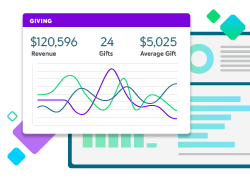How to Structure Your Nonprofit’s Silent Auction Bid Sheets

As a nonprofit professional, you’ve likely hosted—or at least considered hosting—a silent auction. Silent auctions’ main advantage as far as fundraising events go is their flexibility, since they can be held in various formats and tailored to your organization’s supporter base.
But because they’re so versatile, silent auctions have a lot of moving parts and require careful planning to succeed. And one essential but often overlooked part of the planning process is creating bid sheets for each of your auction items.
A well-designed bid sheet can both serve as a data collection tool and a way to catch auction participants’ attention. To help you effectively structure your bid sheets, here are five elements you should make sure to include:
- Your Nonprofit’s Branding
- Item Information
- Starting Bid Amount and Minimum Bid Increments
- “Buy Now” Option
- Supporter Contact Information
Keep in mind that paper bid sheets for an in-person silent auction will likely look different from the mobile bid sheets you’ll create for a hybrid or virtual auction, depending on the capabilities and features of your fundraising software. When choosing a virtual auction platform, make sure it allows you to include all of the above elements within the supporter interface. Let’s dive in!
1. Your Nonprofit’s Branding
Placing your nonprofit’s brand front and center on your bid sheets not only makes them look more professional but also builds trust with auction participants. If supporters recognize your brand before they place a bid, they’ll be confident that their event contributions will support your mission.
Some essential nonprofit branding elements to feature on your bid sheets include:
- Logo. Add your logo to the top of each bid sheet to serve as a visual representation of your organization and its values.
- Tagline. Your nonprofit’s tagline summarizes your mission in an easily digestible format. Place it next to your logo to give new supporters a quick overview of the cause they’re contributing to by participating in your auction.
- Fonts. Use no more than two typefaces on your bid sheets—one for headings and one for body text—and make sure they’re consistent with your logo.
- Color scheme. There are several ways to incorporate your organization’s color scheme into your bid sheets. For example, you could print them on colored paper or add a colorful header design to a white background. No matter how you utilize color, ensure adequate contrast between text and background colors so all written content is readable.
An additional benefit of incorporating your nonprofit’s brand into all of your silent auction bid sheets is increased recognition. The more your supporters come into contact with your brand, the more they will remember it.
2. Item Information
At an auction event, the items are the star of the show. Writing an effective description of each item on its bid sheet can help convince supporters to place generous bids on your high-value auction items.
Here are some ways to make your descriptions more compelling:
- Give each item a catchy title. For example, using a generic title for a vacation package like “Trip to Northern Italy” likely won’t be as attention-grabbing as calling it “Tuscany Culinary Escape.”
- Write concisely. Keep paragraphs short and use bullet points so supporters can quickly skim each description.
- Include all essential information. In addition to listing all of the prizes included in a gift basket or other type of bundle, let supporters know about any restrictions on each item’s use (such as whether a gift certificate expires) so they can make informed decisions.
Beside each description, add the item’s tracking number to ensure your post-event records of who purchased which item at what price will be accurate. It’s also helpful to feature photos of the item or experience on your bid sheets, especially for virtual auctions where you can’t lay out the prizes on tables at an event venue.
3. Starting Bid Amount and Minimum Bid Increments
On every bid sheet, the item’s starting bid amount and minimum bid increments should be clearly marked above the table where supporters will enter their bids. To figure out these amounts for each item, follow this formula:
- Determine the item’s fair market value (FMV), which you can usually find by searching online or asking its provider.
- Set the starting bid amount at 40% of the FMV.
- Set the minimum bid increase at 10% of the starting bid amount.
Let’s say your organization secures two front-row tickets to a popular concert, which have a total FMV of $1,000. The starting bid amount for these tickets would be $400, and the minimum bid increase would be $40.
This pricing formula is why it’s so important to take advantage of nonprofit discounts and solicit in-kind donations when procuring auction items. Besides supporting a good cause, part of the reason supporters enjoy purchasing items at auction instead of buying them outright is the ability to get them at a discounted price. However, your total event revenue needs to be much higher than the upfront costs of your auction items to ensure you can put most of the funds you raise toward your mission.
4. “Buy Now” Option
Another way to maximize the revenue you bring in from certain silent auction items is to include a “Buy Now” option on their bid sheets. It isn’t advisable to do this for every item since it discourages bidding wars, which are a key way to keep supporters engaged during your event. However, a “Buy Now” option can help you make the most of your highest-value auction items, such as:
- Fine art and collectibles. These items are often one of a kind, so supporters who really want them will pay top dollar for them.
- Exclusive tickets. These often cater to specific supporters’ interests—some major fans of certain musicians or sports teams want to see them play live no matter how much they have to pay to do so.
- Vacation packages. According to the fundraising experts at Winspire, travel-related auction items tend to be highly sought after and tend to bring in significant bids. Although there are many nonprofit discounts available through travel providers, it’s rare for a vacation package to be entirely composed of in-kind donations. If a supporter takes the “Buy Now” option, they’ll more than cover its upfront cost and leave you with plenty of revenue to support your mission.
While you could set the “Buy Now” amount at 100% of the item’s FMV, it’s often better to set it at 150% or even 200%. This way, you can still encourage bidding wars among supporters hoping for a discount, but you’ll maximize your revenue if a participant comes along who is happy to pay more than the FMV for an item they really want.
5. Supporter Contact Information
The majority of each bid sheet will consist of a table where auction participants enter their names and bid amounts in two columns. However, it’s best to include two additional columns in each table—one for supporters’ phone numbers, and one for their email addresses.
Asking for this information serves two main purposes. First, having two methods of contact for each winning bidder makes it easier to find them at the end of the event to ensure they claim their items. Second, it helps with donor stewardship because you’ll have a reference to thank each auction participant for their exact contributions, showing that your organization values their individual support.
Some aspects and structural details of your silent auction bid sheets will depend on your organization’s preferences and design capabilities. However, the five elements above are non-negotiable essentials for an effective bid sheet. Catch supporters’ attention with a branded header and well-written item description, be strategic about your starting bid amounts and use of “Buy Now” options, and don’t forget to collect participants’ contact information along with their bids. Happy fundraising!
The Nonprofit CRM Built for Fundraisers
Find out how Blackbaud’s Raiser’s Edge NXT® fits your organization.

